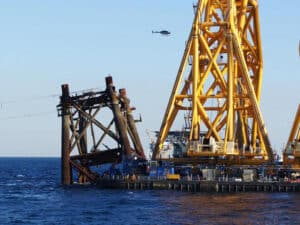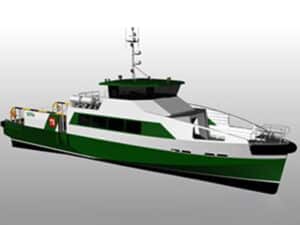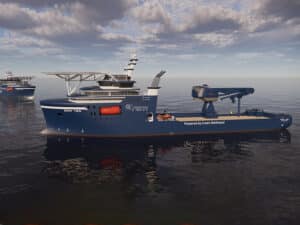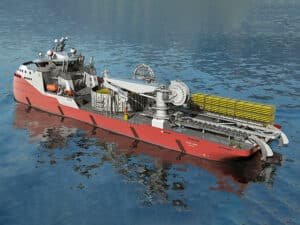
Offshore leasing plan gets few industry cheers
Written by Nick Blenkey
JANUARY 27, 2015 — The Obama Administration today announced a proposed offshore oil and natural gas leasing program for 2017-2022 that National Ocean Industries Association President Randall Luthi called “a small step in the right direction,” though American Petroleun Director of Upstream Erik Milito said it showed “a disappointing lack of commitment to ensuring America’s position as a world leader in energy.”
Unveiled by Secretary of the Interior Sally Jewell and Bureau of Ocean Energy Management (BOEM) Director Abigail Ross Hopper, the Draft Proposed Program (DPP) includes 14 potential lease sales in eight planning areas – 10 sales in the Gulf of Mexico, three off the coast of Alaska, and one in a portion of the Mid- and South Atlantic. The areas available in Alaska have been limited by a decision by President Obama, made public today, to use his authority under the OCS Lands Act to put portions of the Beaufort and Chukchi Seas off-limits for drilling.
The draft is a step in a multi-year process. Before the program is finalized, the public will have multiple opportunities to provide input. Today’s draft proposal was informed by more than 500,000 comments from a wide variety of stakeholders and states.
“The draft proposal prioritizes development in the Gulf of Mexico, which is rich in resources and has well-established infrastructure to support offshore oil and gas programs,” said Secretary Jewell. “We continue to consider oil and gas exploration in the Arctic and propose for further consideration a new area in the Atlantic Ocean, and we are committed to gathering the necessary science and information to develop resources the right way and in the right places. We look forward to continuing to hear from the public as we work to finalize the proposal.”
The options in the draft proposal involve sales in offshore areas that have the highest oil and gas resource potential, highest industry interest, or are off the coasts of states that expressed a strong interest in potential energy exploration, while still considering potential environmental impacts, stakeholder concerns, and competing uses of ocean and coastal areas.
GULF OF MEXICO
The draft proposal includes ten sales in the Gulf of Mexico and takes a new approach to lease sales in the region by proposing two annual lease sales in the Western, Central, and the portion of the Eastern Gulf of Mexico that is not subject to Congressional moratoria. This shifts from the traditional approach of one sale in the Western and a separate sale in the Central Gulf each year.
“This new approach will allow for BOEM to more effectively balance the sales while providing greater flexibility to industry to invest in the Gulf, particularly given the significant energy reforms recently adopted by the Mexican government,” said BOEM Director Hopper
ALASKA
In Alaska, says Interior, the draft proposal continues to take a careful approach by utilizing the targeted leasing strategy set forth in the current program, which recognizes the substantial environmental, social and ecological concerns in the Arctic. The draft proposal proposes one sale each in the Chukchi Sea, Beaufort Sea, and Cook Inlet areas.
“We know the Arctic is an incredibly unique environment, so we’re continuing to take a balanced and careful approach to development,” said Secretary Jewell. “At the same time, the President is taking thoughtful action to protect areas that are critical to the needs of Alaska Natives and wildlife.”
Four of the five areas withdrawn today by President Obama were previously excluded from leasing in the current 2012-2017 oil and gas program; three of the five were also excluded by the prior Administration. Those areas include the Barrow and Kaktovik whaling areas in the Beaufort Sea, and a 25-mile coastal buffer and subsistence areas in the Chukchi Sea. The withdrawal also includes the biologically rich Hanna Shoal area in the Chukchi Sea, which has not previously been excluded from leasing. Extensive scientific research has found this area to be of critical importance to many marine species.
The proposed Alaska sales would be scheduled late in the program to provide additional opportunity to gather and evaluate information regarding environmental issues, subsistence use needs, infrastructure capabilities, and results from any exploration activity associated with existing leases from previous sales.
ATLANTIC
The draft proposal invites public comment on one potential lease sale late in the program for a portion of the Mid- and South Atlantic OCS, which includes areas offshore Virginia, North and South Carolina and Georgia.
“At this early stage in considering a lease sale in the Atlantic, we are looking to build up our understanding of resource potential, as well as risks to the environment and other uses,” said Secretary Jewell.
The potential lease sale would require a 50-mile coastal buffer to minimize multiple use conflicts, such as those from Department of Defense and NASA activities, renewable energy activities, commercial and recreational fishing, critical habitat needs for wildlife and other environmental concerns.
The July 2014 Programmatic Environmental Impact Statement on Atlantic Geological and Geophysical activities furthered the Atlantic area strategy by establishing a path forward to update information on the region’s offshore oil and gas resources, which is more than 30 years old. Today’s proposal is in line with comments received from adjacent states and reflects the Administration’s thoughtful approach to potential lease sales in new areas, pending further public review and comment.
PACIFIC
Areas off the Pacific coast are not included in this draft proposal, consistent with the long-standing position of the Pacific coast states opposed to oil and gas development off their coast.
NEXT STEPS
In conjunction with the announcement of the DPP, the Department is also publishing a Notice of Intent to Develop a Draft Environmental Impact Statement (EIS), in accordance with the National Environmental Policy Act (NEPA). Following significant public comment and environmental review, the Department will prepare a Draft EIS and Proposed Program, and a Final EIS with the Proposed Final Program (PFP).
NOIA COMMENT
National Ocean Industries Association President Randall Luthi today issued the following statement on the 2017-2022 Draft Proposed OCS Oil and Gas Leasing Program:
The National Ocean Industries Association is pleased that the Department of the Interior has released the 2017-2022 draft proposed offshore oil and natural gas leasing program but expresses concern over its unnecessary and counterproductive limits that may jeopardize America’s long term energy security.
Our members are encouraged by the decision to further analyze the mid and south Atlantic areas, which have not been included in a leasing program for over two generations. In fact, over 85 percent of the outer continental shelf has been shuttered to exploration for decades, so the consideration of new areas in the Atlantic is a step in the right direction. However, we remain disappointed that more areas that are currently off-limits were taken off the table for consideration as part of this five-year program, and that the total number of lease sales has been reduced from the previous program rather than increased. We are also concerned by additional restrictions in the plan, like the 50 mile buffer zone off the Atlantic.
Opening America’s OCS for energy development could provide substantial benefits to all Americans. A recent study shows that by opening the Atlantic, Pacific, and Eastern Gulf of Mexico, America could, by 2035, create more than 838,000 jobs annually, spur nearly $449 billion in new private sector spending, generate more than $200 billion in new revenue for the government, contribute more than $70 billion per year to the U.S. economy, and add more than 3.5 million barrels of oil equivalent per day to domestic energy production. Other nations, including Canada, Cuba, Mexico, Norway, Greenland, Brazil and Ghana, have recognized the energy and economic opportunities off their own shores and are exploring new offshore areas.
While other countries are moving ahead, it is disappointing that the Administration is not taking this opportunity to include additional OCS areas in their draft plan. For example, while it is gratifying to see sales considered off the coast of Alaska, the Administration’s plan for the Alaska offshore continues to hobble the people of Alaska and the overall energy portfolio of the United States. Instead of a robust plan for potential development in an area that holds immense resource potential, the plan actually reduces the areas available for further analysis. This is a political plan, not a plan based on science and resource data. While the certainty of sales is a small step forward, removing Alaska’s opportunity to recognize its resource potential is a giant leap backward that also unnecessarily restricts America’s ability to become more energy sufficient and to firmly establish leadership in the world energy arena.
Likewise, the omission of the rest of the Atlantic, the Eastern Gulf of Mexico and the Pacific also demonstrates a continued lack of long term vision for energy security and reliability. The Eastern Gulf of Mexico is a logical area for new exploration and development since there is already industry and infrastructure in the rest of the gulf. Additionally, technology now provides methods for exploration out of the view shed, a concern of many Floridians. The draft proposed program could have been much more robust had it included further analysis of the Eastern Gulf of Mexico with the caveat that should Congress lift the exploration ban before 2022, new areas could be included in a 2017–2022 leasing schedule. Nova Scotia and New Foundland have been developing in the Atlantic for years, but the U.S. will continue to turn a blind eye to what potential might be off our own northern Atlantic shore. As for the Pacific, it has been a source of oil for generations, but without the ability to look in new areas and purchase new leases there, that source will continue to dry up.
For decades in the Gulf of Mexico and other places around the world, energy development, conservation efforts, and other industries — be it tourism, commercial or recreational fishing, or others — have not only coexisted, but thrived alongside each other; to purport that restrictions like those included in the draft plan are necessary for protecting vital resources and existing industries is misleading at best.
It is important to note that this is not a partisan issue. House and Senate Democrats and Republicans and the vast majority of the American public have stated their support for the safe exploration and production of America’s offshore energy resources. The oil and natural gas industry is a huge driver of our economy and is vital to our long term energy security, and opening new offshore areas for exploration and possible development will greatly enhance both.
Despite the opportunities it misses, the draft proposed program is a small step in the right direction. NOIA and our members look forward to participating in the commenting and hearing process.”
API COMMENT
The proposed offshore oil and natural gas leasing program released by the Department of the Interior today, along with other recent actions to restrict energy development, show a disappointing lack of commitment to ensuring America’s position as a world leader in energy, said American Petroleum Institute Director of Upstream Erik Milito.
“The administration is compromising our ability to compete globally by restricting so much of the nation’s oil and natural gas resources,” said Mr. Milito. “The draft offshore leasing program proposed today completely ignores areas where oil and natural gas development could create more than half a million new American jobs and generate hundreds of billions of dollars for the government.
“While considering the Atlantic for potential development is a good step, the administration’s proposal represents the bare minimum for potentially opening that area by including only a single lease sale six years from now.”
In her news conference, Secretary Jewell noted the lease sales were a minimum that could be “narrowed or taken out entirely in the future.”
“New restrictions offshore Alaska and a rejection of billions of barrels of oil from the coastal plain of ANWR, duplicative new regulations on industry operations, and the government’s refusal to even consider leasing in the Eastern Gulf of Mexico and the Pacific are tying America’s hands against a future of affordable and reliable energy,” said Mr. Milito.
“Staying competitive and reducing our dependence on oil from abroad depends on planning and decisions made today. What the administration has in fact proposed represents delayed economic opportunity and could cost us a lot of jobs and revenue to the government and threaten our energy security.
“This is our energy moment, and we need smart, forward-thinking policies to realize this opportunity.”





Leave a Reply
You must be logged in to post a comment.